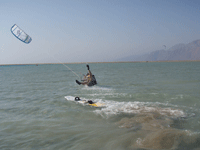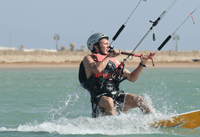- Details
- Written by: Mike Walker
Lift-off!
Is it a bird, is it a plane? No, it’s Derek doing his Superman impression again. ‘Aaarrgh!’ escapes his lips as he flies through the air at Mach Ten, feet ejected from the straps of his board, propelled by his fully-powered-up kite. Splat!
There’s definitely a knack to this kitesurfing thing, and it seems that our small group is on the way to finding it. David (jammy so-and-so who ‘gets’ kiting almost straight away), Michelle, his wife (anything he can do she can do better), Derek (sport junkie who wants to take his land-kiting skills into the water) and myself are all under the patient tutelage of our instructor, Wes.
‘Racing bike... mountain bike... racing bike!’ Wes instructs, to help us get in the right position to control the power using the bar attached to the kite lines. He’s not a shouty instructor, preferring instead to give people individual attention. I’m reassured by his calm manner, as kitesurfing has a reputation as a dangerous sport.
I have visions of doing myself or someone else damage, but Wes, who has escaped from Bournemouth to the Red Sea resort of Dahab, runs us through all of the safety features of the kiting set-up. He tells us to keep well upwind of other kiters, how to use the quick-release pull cord on the kiting lines and, as a last resort, how to ditch the kite from our harness. We even borrow a kite manual to read up on all the safety guidelines.
We’re in a lagoon – a safe place to learn to kitesurf, as you are enclosed by sandbars and so can easily find safety by walking back along a sandbar to the beach. Normally, exposed coastal locations are not the best places for beginners, as you can get blown out to sea in an offshore breeze. It is also very hard to launch and head out upwind on an onshore breeze.
A wind that’s halfway between onshore and across the shore is best for kitesurfing, even for experienced riders, and even then the wind direction is liable to change, making learning self-rescue an absolute must.
Wes tells us: ‘A guy got caught up in the currents off Christchurch near Bournemouth when the wind changed, but he deflated his tubes, losing all his buoyancy, and tried to swim in. He drifted out in strong currents and died.’ A sobering thought for anyone thinking they can just buy the kit and give it a go.
Serious stuff out of the way, we’re now all chomping at the bit to learn. The course is meant to run over 10 hours, as and when the conditions are good, but it ends up running way over this time. Wes is even happy to sacrifice a morning lie-in to get to work extra-early when the tide-influenced lagoon is filled with enough water.
 The lagoon is at the end of the long beach at Dahab, one of the best places to windsurf in the world. We’re not here to windsurf, though, and the first day starts with a 15-minute trek down to the lagoon to pump up the kites (we’re using kites where the leading edge is inflated) and set up the lines.
The lagoon is at the end of the long beach at Dahab, one of the best places to windsurf in the world. We’re not here to windsurf, though, and the first day starts with a 15-minute trek down to the lagoon to pump up the kites (we’re using kites where the leading edge is inflated) and set up the lines.
Bit by bit over the next few days we learn to fly the kites and control the amount of power in them, then we take to the water with some introductory body dragging (as it sounds!).
Squeals resound over the water as we bounce off downwind on our fronts, grasping our kites. Even Michelle, initially dubious about trying body dragging across the lagoon, turns around with a gleeful smile on her face after her dunking. ‘That was awesome,’ she says.
Finally, we learn how to get going and sail across the wind. It takes a lot of failed attempts before we ‘water start’ for the first time, and we supportively continue to coach each other with Wes’s instructions when the lessons are over. We half-learn, half-feel our way though the motions of preparing our kite at a stable position, slipping our feet into the straps of our board, positioning our bodies in preparation, and manoeuvering the kite in the sky to launch us onto the plane (where the board lifts up and skims across the water).
Wow, you’re up (or have been launched forwards – double splat!), so now you need to ‘sine wave’ the kite at the edge of the ‘power zone’, a figure of eight movement that propels you along, across the wind.
Sounds complicated? Well, it is, and we haven’t even mentioned turning. Kiting skills are technical and you need loads of wind awareness, as the power in the kite increases with gusts. But if you can summon up all of the required co-ordination it’s well worth it for the feeling of achievement as you skim along the water’s surface. Elation!
I actually found kitesurfing less tiring on the arms than windsurfing – making it an ideal water sport for women, who generally have less muscle power than males.
Although we didn’t get as much time on the water as we would have liked to practise our new-found skills, due to the tides, we managed to keep ourselves busy. Compared to the mega-resorts spreading around the Egyptian Red Sea, Dahab has maintained a hip, laid-back vibe and there is plenty to do besides chilling out in the many bars, including an early-morning bike ride (mostly along tarmac), windsurfing, Scuba Diving and snorkelling among the native exotic fish.
KITE SPEAK
Chicken loop – part of the system for attaching the harness to the kite lines
Chicken bone – the other part of the system for attaching the harness hook to the kite lines
Power zone – the kite generates the most lift (pull) in this area, which covers a 60-degree downwind arc.
Zenith – this is the neutral position where kitesurfers can place the kite before starting off or stopping.
Kitemare – a kitesurfing accident
5 BEST FOR CULTURE VULTURES
Day trip to Luxor
A day trip to Luxor is a 50-minute hop in a plane from Sharm (about 45 minutes down the road from Dahab). See the Valley of the Kings and three of the main temples, with minimal coach time between them, and an expert guide.
Visit St catherine’s monastery
High up in the desert mountains, this 5th-century monastery is about a two-hour drive away from Dahab. See what they claim is the actual burning bush that Moses encountered. You can climb the summit of Mount Sinai (2,285 metres). Most people start the walk up from the monastery at midnight to reach the summit in time for dawn.
Bedouin tea in the desert
Just 10 minutes outside Masbat (Dahab is a fairly laid-back resort for windsurfers and divers and Masbat is the town where the locals live and shop) you can eat Bedouin food with the tourism-savvy local tribes. You travel by camel and sit under the Milky Way on Arabian rugs. We drank bitter tea as our guide told us of the social codes of the Bedouin people today and a little bit of history.
Snorkelling or diving at the Blue Hole
The famed Blue Hole is just along the coast from Dahab, and has fabulous diving or snorkelling – 103m deep, the hole has an excellent coral wall.
Visit Petra
Travel the 150km to Petra in neighbouring Jordan by local flight or coach and ferry. Feel like Indiana Jones as you make the final approach to the rose-coloured city by donkey or on foot. The ancient city is hidden in a mountain gorge and laid undiscovered for hundreds of years.
IN THE KNOW
Getting there
Dahab is a one-hour transfer from Sharm el Sheikh airport. Christine went with Neilson (www.neilson.co.uk), which charters flights from Thomas Cook Airlines, flying from London Gatwick, Manchester, Birmingham, Newcastle and Bristol. Flights from Gatwick to Sharm El Sheikh take just over five hours.
The centre
The Neilson centre at Dahab is on the beach, and run out of the Coralia Club hotel.
Accommodation
There are different levels of accommodation. For a supplement, you can get superior/family rooms with a sea view.
Activities
Included in the cost of the holiday are: mountain biking, dinghy sailing and windsurfing (equipment and tuition to RYA levels), a try-dive and most kids’ clubs. Not included is the nursery care (4-24 months) and high-level tuition for eight to twelve year olds.
Eating and drinking
Waterside restaurants and cafes, for example Funny Mummies, serve mezes of humous and different dips, fresh seafood platters and meat grills, topped off with the ubiquitous apple-flavoured shisha pipe.
Talk about it (phonetically)
Hello – Salam Aleikum
Thanks – Shoukran
Currency
Exchange rate (Sept 2009): there are 9.13 Eygptian Pounds to £1
Time zone
Two hours ahead of GMT
More on egypt
See touregypt.net
Images: shutterstock.com, Aynia Noeve, Clare Edmead, Christine Ottery and Dick Stanger


